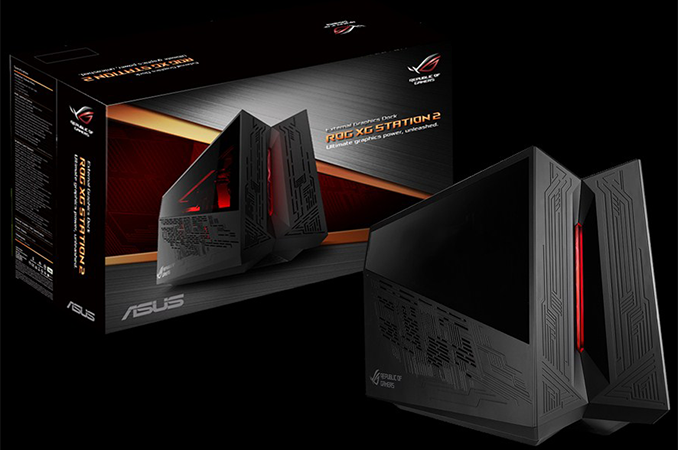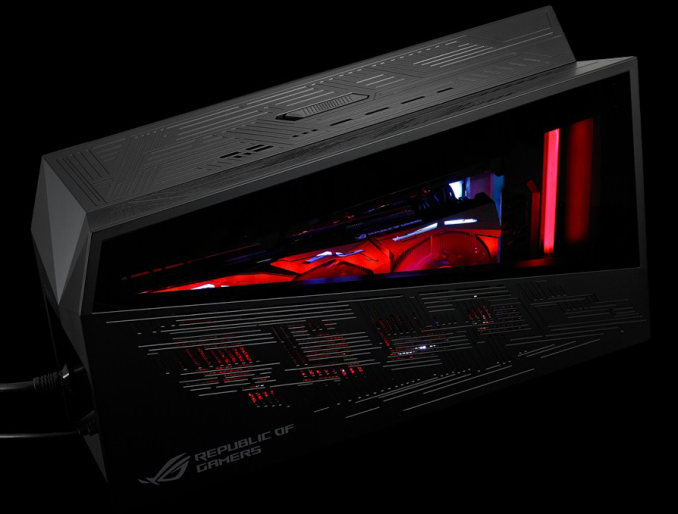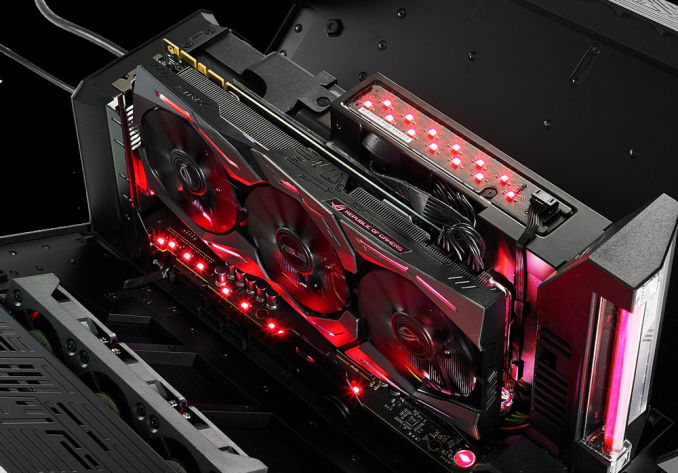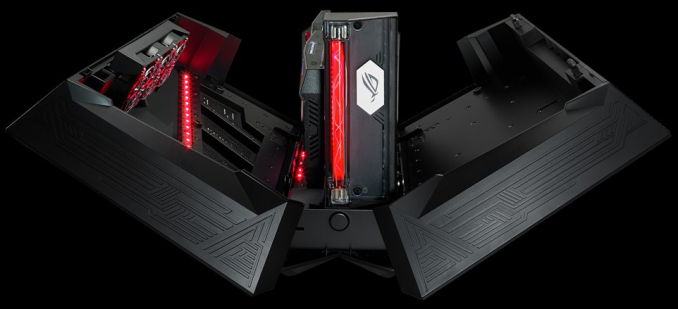ASUS ROG XG Station 2 eGFX Enclosure with Thunderbolt 3 Launched
by Anton Shilov on December 20, 2016 12:01 PM EST- Posted in
- GPUs
- Asus
- External GPU
- Thunderbolt 3
- eGFX
- XG Station

ASUS last week finally launched theROG XG Station 2 external GPU chassis, to enable Thunderbolt 3 systems to implement discrete graphics. The eGFX enclosure from ASUS integrates a 600 W PSU to ensure compatibility with power-hungry graphics adapters, and can house not only a video card but also an additional 2.5” storage device and bundles in extra USB 3.0 ports. The design of the external GPU box features signature ‘Republic of Gamers’ elements with red LEDs and Mayan-style patterning.
ASUS was among the pioneers of external graphics adapters in 2007 when it first showcased its XG Station with an integrated NVIDIA GeForce 8600 GT GPU. The dock used the Express Card interface, was not upgradeable, was only compatible with select ASUS laptops and its performance was not enough for then-popular games like Crysis (which is partly why it never took off). The company did not bury the idea of external graphics for laptops completely, and at CES 2014 the company showcased its XG Station 2 with a Thunderbolt 2 interface co-developed with SilverStone. The chassis was upgradeable and could house a variety of graphics cards, but the entire platform itself had numerous limitations when it came to bandwidth, hot-plugging, driver support and some others which is why that product was not even released. In January this year, ASUS demonstrated yet another XG Station 2, this time with a proprietary physical interface that used two USB Type-C cables (albeit with 32 Gb/s maximum bandwidth) and was to be compatible with select ASUS laptops. Around that time Intel had managed to finalize its eGFX over Thunderbolt 3 specification with some external help from AMD (see XConnect), whereas Razer showcased their compatible solution up and running (and later commercialized it). The Thunderbolt 3 graphics appeared to be so robust that ASUS decided to drop its proprietary external graphics interface and go with TB3 instead. At Computex in June, the company showcased its XG Station 2 with a Thunderbolt 3 interface, which will finally hit the market in 2017, a decade after the original XG Station (and in the third iteration of its own).
The ASUS ROG XG Station 2 looks exactly like the one demonstrated at Computex: the Mayan patterns serve like the openings to ensure proper cooling and the enclosure is equipped with multiple red LEDs controlled using the ROG AURA technology. The eGFX chassis from ASUS can accommodate a qualified double-wide PCIe x16 video card that is up to 12.2”/310 mm long. Due to TB3 bandwidth limitations, as with all TB3 eGFX enclosures, the GPUs are limited to PCIe 3.0 x4 bandwidth. The company does not specify the exact height of graphics adapters that the XG Station 2 can host, but for demonstrations it has used its ROG Strix boards with enlarged PCBs, hence it is safe to assume that there is plenty of vertical space inside the enclosure. To ensure that graphics cards receive enough power, ASUS integrated a 600 W PSU into the XG Station 2, a more powerful unit than in any other contemporary eGFX chassis. The enclosure has three 80-mm fans to pump up cool air into the box to guarantee proper cooling and enhance GPU overclocking potential for those who need it.
| ASUS ROG XG Station 2 eGFX Chassis Specifications | ||||
| Max Video Card Size | Double-Wide, 12.2" Long (312 × 170 × 44 mm) |
|||
| Max Video Card Power | 500 W (?) | |||
| Connectivity | 1 × Thunderbolt 3 (~40 Gbps via active cable) | |||
| Chassis Size | 6.22 × 17.95 × 10.94 inches (158 × 456 × 278 mm) |
|||
| Internal PSU | 600 W 80 Plus Gold | |||
| System Requirements | Thunderbolt 3 eGFX Certified PC Thunderbolt 3 w/Active Cable (included) Windows 10 |
|||
| Compatible ASUS PCs | ROG G701VI ROG GL502VM ROG GL702VM Transformer T303UA Transformer T305CA Official List |
|||
| Compatible Graphics Cads | AMD Radeon RX-series and later NVIDIA GeForce GTX 10-series and later |
|||
| Shipping Date | Early 2017 | |||
| Price | Not cheap at all | |||
UPDATE: The XG Station 2 does not feature any storage bays, contrary to what earlier documents and reports indicated.
The ROG XG Station 2 is not just an eGFX enclosure, but also rather an expansion dock for laptops that adds Gigabit Ethernet, four USB 3.0 ports as well as one 2.5” bay for a SATA hard drive or an SSD. It is noteworthy that the four USB ports are not involved in the TB3 connection and do not use PCIe bandwidth, but have to be connected using a USB 3.0 Type-B cable (which means that the XGS2 needs three cables: TB3, USB and power). From connectivity and expandability standpoint, the ASUS ROG XG Station 2 is on par with PowerColor’s Devil Box, but leaves the competitor behind it when it comes to the wattage of internal PSU.
When it comes to compatibility, the ASUS ROG XG Station 2 should work with all systems that feature Thunderbolt 3 and support of eGFX through BIOS and TB3 firmware. ASUS lists its computers that can work with its external GPU enclosure on its website, but also lists systems from other makers. Nonetheless, it should not be a problem for the ROG XG Station 2 to work with appropriate non-ASUS PCs (e.g., with Razer’s Blade Stealth) with TB3 and appropriate BIOS/FW.
| Comparison of Thunderbolt 3 eGFX Chassis | ||||||||
| ASUS ROG XG Station 2 | AKiTiO Node |
BizonTech BizonBox 3 |
PowerColor Devil Box |
Razer Core |
||||
| Chassis Dimensions | Length | 45.6 cm 17.95 in |
42.8 cm 16.85 in |
36 cm 14.17 in |
40 cm 15.748 in |
34 cm 13.38 in |
||
| Height | 27.8 cm 10.94 in |
22.7 cm 8.94 in |
20.5 cm 8.07 in |
24.2 cm 9.52 in |
21.84 cm 8.6 in |
|||
| Width | 15.8 cm 6.22 in |
14.5 cm 5.71 in |
8 cm 3.5 in |
17.2 cm 6.77 in |
10.5 cm 4.13 in |
|||
| Max Dimension of Compatible Graphics Card | Length | 31.2 cm 12.2 in |
||||||
| Height (PCB+Cables) |
over 14 cm over 5.51" |
17 cm 6.7 in |
over 14 cm over 5.51" |
14 cm 5.51 in |
15.2 cm 5.98 in |
|||
| Width | 4.4 cm 1.73 in |
5 1.96 in |
4.4 cm 1.73 in |
|||||
| Maximum GPU Power | 500 W (?) | 300 W (?) | 375 W | |||||
| PSU | Wattage | 600 W | 400 W | 200W/400W | 500 W | |||
| Form-Factor | internal proprietary | SFX | external | internal proprietary | ||||
| Cooling Fans (mm) | 3 × 80 | 120 | 2 × 60 | unknown | 3 × 80 | |||
| Connectivity | Thunderbolt | 1 × TB3 | 1 × TB3 | 2 × TB3 | 1 × TB3 | |||
| Ethernet | 1 × GbE | - | 1 × GbE | |||||
| USB | 4 × USB 3.0 1 × USB-B |
- | 4 × USB 3.0 | |||||
| SATA | - | - | 1×SATA 6Gb/s | - | ||||
| DisplayPort | - | - | 1 × DP 1.2 | - | ||||
| Availability | 1/2017 | 12/2016 | 10/2016 | 4/2016 | ||||
| Price | $? | $299 | $649 | $379 | $499 | |||
ASUS plans to start sales of the ROG XG Station 2 in early 2017. The company yet has to disclose the final pricing, but given all the advantages that the product has, we expect it will cost more than an average eGFX box.
Related Reading:
Source: ASUS



















27 Comments
View All Comments
rtho782 - Wednesday, December 21, 2016 - link
The but I don't get is, does it require an external monitor? In which case I may as well just have a desktop.If not, then given that you need to move the frames back over the pcie link, it really is going to struggle for bandwidth.
1080p60 @24 bit colour is getting up to 10% of the bandwidth of pcie 3.0x4. As soon as you go 1440p, you double the bandwidth. 4k, is quadruple the bandwidth, 40% of the total, and 120hz also doubles it.
1080p60 might be accepted today, but just around the corner people will be looking for 4k120 HDR12, which will be 120% of the bandwidth of pcie 3.0 x4, leaving no future on this solution.
xype - Thursday, December 22, 2016 - link
> In which case I may as well just have a desktop.Uhm. Then it’s not for you?
I think people buying these don’t care that much about the "future" and their games, but being able to play games with their laptops right now.
Me, I’d be in the market, maybe sometime in 2017. I have a work-issued new MBP that is an amazing machine for the work I do. Getting an eGPU box with space for an SSD would save me some money, and I have an external screen at home anyway.
I know that a lot of people find the idea of eGPUs interesting, but when it comes down to it, it’s just not something that many will even consider buying. It’s just weird that they keep saying so online as if there would ever be a realistic option that would make them consider such hardware in the first place (short of an eGPU box with a 1080 for $250 in total).
Which is also the reason why most of these are expensive. The market is very small and the people who want/need one will pay for it.
MadAd - Tuesday, December 20, 2016 - link
*waits for the model with half the power, 1 slot, 1 fan and a fraction of the priceI guess I have waited this long, another year wont make any difference. All I want is ITX based desktops with a remote GFX card for my daily/bi daily dose of shooting players in Planetside 2.
Once im done I want to shut off the graphic card completely, and not be tied to big PC cases sitting around 24/7 just because I like to game. I have a NAS, ITX makes so much sense for desktop, the only thing missing is a decent external video caddy selection.
eldakka - Saturday, December 24, 2016 - link
There are small footprint ITX cases that can support a single dual-slot graphics card. Much more cost-effective and space efficient than a tiny ITX case + extra tiny external case for GPU.rl2e - Wednesday, December 21, 2016 - link
They list ROG GL502VM as compatible, but I don't think that laptop even has a TB3 port.Traffic - Wednesday, May 24, 2017 - link
Its so funny that people hasnt found this solution almost at all. What could be better, have a full graphics capable computer at home with easy to carry around 2 in 1 for example. Just wondering can one buy a miix 720 for example and connect it with Asus XG2 with good GPU it would be something.Nataku4ca - Friday, October 27, 2017 - link
I agree with you, I've been eyeing new equipment for a few month now as my current desktop is almost 10years old and on it's last leg. I've pretty much decided to get the Miix720 and found a guy who tried it with the Razor core and it works. People really need to understand a few things to see the value for these setup.1. It's really a docking station replacement, a docking station from each manufacturer generally runs around 150~300CAD depending on number of ports and other features. The XG took care of most of the things someone like me would care about (USB expansion, network port, video out, more HDD space)
2. For a 2-in1 like the Miix720, the extra bay for harddrive really saves the day. I've shopped around for external enclosure (USB) as I have some extra drives, but if I'm just buying enclosure they're almost always more than 80CAD. having this would save me a bundle of money. (yes you can buy new external drives with drives included for likely cheaper, but why waste what you have)
3. Not everyone would agree, but I've been imagining a day where I have one portable device that I can do everything on, but won't be bulky like a gaming laptop. The XG allows for that. If I replace my monitors as well so that they can be daisy chained, would have 1 or may be 2 cables depending on the solution I go with, to plug into the 2-in-1 and everything else can be tucked away nicely. makes for a much cleaner and nicer looking desktop. (If you're married like me, you likely know what I mean and why it's appealing...)
4. as bulky as this may seem (and as sad that LAN party is no longer a thing) it makes me moving to another place for gaming due to kids screaming much simpler when I need to (again something probably only parents would appreciate)
5. Well, kind of have to realize that this is just the beginning, kind of like how 2-in-1s were at the beginning, or how much the cheapest desktop cost in the early 90s, or that 600CAD 160GB SSD I bought when they first came out. it's NEW!
rant over, hopefully I'll get my setup together in a month or two